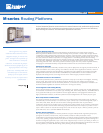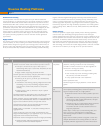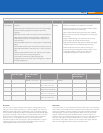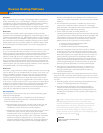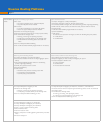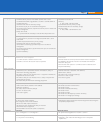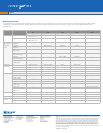
Page 2
M-series Routing Platforms
Rich Packet Processing
A broad portfolio of services can be layered on top of VPNs for additional
revenue generation. A comprehensive suite of multicast capabilities, including
multicast over MPLS VPNs, enables efficient distribution of premium content.
Hardware-based IPv6 and a number of IPv6 migration tools such as IPv6 over
MPLS ease access to the benefits of this next-generation IP protocol without
performance compromise. NAT and stateful firewall can be configured per VRF
to enable network-based security for additional revenues and IPSec can be
used to support a premium security service for end users with high security
requirements. The M-series Service-Built Edge is continuously enhanced with
new packet processing capabilities to ensure maximum revenue generation
opportunities.
Highly Reliable
The M-series service-built architecture has been fundamentally constructed with
scale and stability in mind, including the modular and fault-protected design of
JUNOS software along with a rigorous system testing process. Furthermore, all
M-series routers offer redundant power and cooling and the M10i, M20, M40e,
M160, and M320 offer fully redundant hardware including redundant Routing
Engines and Switching/Forwarding Engine Boards. JUNOS software features
enhance this redundant architecture by enabling non-stop forwarding in the
event of a routing engine failure via a Hitless Switchover and when a minor
software upgrade is required by supporting In-service Software Upgrades. This
functionality augments other high availability capabilities that include graceful
protocol routing restart, MPLS fast reroute, VRRP, SONET APS, SDH MSP, BFD,
and LACP.
Robust Security
All M-series platforms support highly scalable J-Protect filtering capabilities,
unicast reverse path forwarding and high performance rate limiting for
industry-leading DOS attack protection. The J-Protect security capabilities of the
M-series platforms can be further enhanced with the Adaptive Services PIC that
accelerates, in hardware, additional network-based security services such as
high-speed NAT, stateful firewall with attack detection, and J-Flow accounting.
With the rich feature set of JUNOS software combined with industry-leading
ASIC technology, the M-series Service-built Edge provides a new level of reliable
and secure service delivery at the edge of service provider networks.
Advantage
Features Benefits Features Benefits
New Service
Models
• Industry's most comprehensive VPN portfolio meets the largest
number of customer needs and maximizes provider revenues
• Run Layer 2 Virtual Circuit, Layer 2 VPN, Layer 2.5
Interworking VPNs, Layer 3 2547 VPN, VPLS, IPSec, IP over
IP, GRE simultaneously
• Highly scalable, supporting thousands of VPNs
• Granular QoS with low latency and jitter performance to support
voice, video, and other real time applications
• Per DLCI, per VP, per VC, per VLAN, per channel (DS0),
and per port QoS
• Classification, rate limiting, shaping, weighted round robin
scheduling, strict priority scheduling, weighted random
early detection, random early detection, and packet
marking
• Mapping Layer 2 (802.1p, CLP, DE) to Layer 3 QoS (IP
DSCP, MPLS EXP)
• Hardware-based IPv6 performance, IPv6 over MPLS, IPv6 over
IPv4 GRE tunnels, and IPv6/IPv4 dual stack functionality
• Robust multicast support including IGMP v1/v2/v3, PIM-SM, PIM-
DM, MLD, SSM, RP, MSDP, BSR, multicast in MPLS/BGP VPNs to
support resource-efficient delivery of high-value content
• Network-based security services including NAT and stateful
firewall, and NAT and stateful firewall per VRF
• MLPPP, MLFR .15 and MLFR .16, 802.3ad (including LACP) for
aggregated links
• J-Flow accounting, source class usage, and destination class
usage for flexible billing on a per application or per CoS resource
usage basis and for distance-based billing.
• Multivendor network management solution through partnerships
• Industry-leading, XML-based JUNOScript API facilitates
third-party and in-house OSS development
Services
Everywhere
• One feature-rich JUNOS image runs across all M-series
platforms, ensuring consistent services and enabling
providers to market all services to all users regardless of
connection or serving area density
• From the smallest PoPs to the largest PoPs
• Over virtually any access technology including ATM,
FR, Ethernet, and TDM connections
• At any speed from DS0 to OC-192/STM-64
• Lowers operational costs
• Seamless migration to larger platforms to meet network
growth
More from
Less
Infrastructure
• Service-built architecture provides clean separation between
control plane, forwarding plane, and services plane to
support multiple services on a single platform
• Maximum revenue with the lowest possible capex and
opex
• Consolidate functions previously performed by discrete
devices such as NAT, stateful firewall, IPSec, and QoS
into a single M-series platform
• Multiple services on a single platform allows customers
to trial many different services without capital
investment and then to scale successful services to
large user populations
• Robust Layer 2 VPNs, Layer 2.5 Interworking VPNs, and
Layer 2 to Layer 3 QoS mapping for transparently
consolidating multiple networks to a common IP/MPLS
infrastructure
• Logical routers enables providers to segment a router into
multiple administrative and routing domains, so that two
completely different organization can share infrastructure



